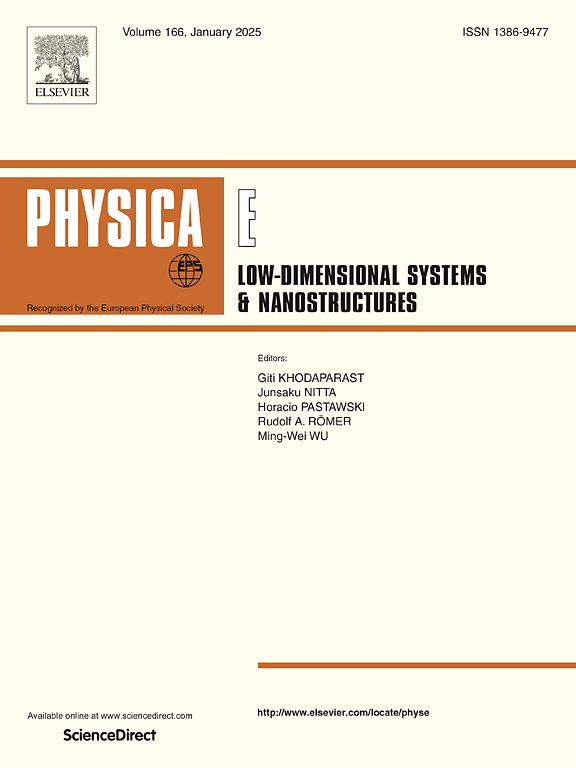周期性掺杂石墨烯的非线性筛选与电荷重分布
IF 2.9
3区 物理与天体物理
Q3 NANOSCIENCE & NANOTECHNOLOGY
Physica E-low-dimensional Systems & Nanostructures
Pub Date : 2025-04-18
DOI:10.1016/j.physe.2025.116250
引用次数: 0
摘要
二维(2D)系统中电荷的库仑势屏蔽问题有一个有趣的解决方案,即由于面外电场的幂律距离屏蔽因子。这与指数筛选的三维病例非常不同。电场的远程作用导致电子从二维异质结构的高掺杂区域有效流入到低掺杂区域。在石墨烯和其他具有线性电子能谱的材料中,这种低掺杂区域的流入也会发生,但其有效性取决于掺杂水平。它可用于制造高导电通道。我们提出了一种理论,用于确定沿一维周期性掺杂的石墨烯片中的电子势和浓度,同时考虑到远程二维筛选的所有影响。这导致了一个本质上非线性的积分-微分问题,该问题通过计算廉价的算法在数值上解决。类似的非线性问题出现在由线性光谱材料制成的大量掺杂二维异质结构中。本文章由计算机程序翻译,如有差异,请以英文原文为准。
Nonlinear screening and charge redistribution in periodically doped graphene
The screening problem for the Coulomb potential of a charge located in a two-dimensional (2D) system has an intriguing solution with a power law distance screening factor due to out-of-plane electrical fields. This is crucially different from a three-dimensional case with exponential screening. The long-range action of electric fields results in the effective inflow of electrons from high-doped regions to low-doped regions of a 2D heterostructure. In graphene and other materials with a linear energy spectrum for electrons, such an inflow in low-doped regions also occurs, but its effectiveness is dependent on the doping level. It can be used to fabricate high-conducting channels. We propose a theory for determining electron potential and concentration in a graphene sheet periodically doped along one dimension, taking into account all effects of long-range 2D screening. This results in a substantially nonlinear integro-differential problem, which is solved numerically via a computationally cheap algorithm. Similar nonlinear problems arise in a wide range of doped 2D heterostructures made of linear spectrum materials.
求助全文
通过发布文献求助,成功后即可免费获取论文全文。
去求助
来源期刊
CiteScore
7.30
自引率
6.10%
发文量
356
审稿时长
65 days
期刊介绍:
Physica E: Low-dimensional systems and nanostructures contains papers and invited review articles on the fundamental and applied aspects of physics in low-dimensional electron systems, in semiconductor heterostructures, oxide interfaces, quantum wells and superlattices, quantum wires and dots, novel quantum states of matter such as topological insulators, and Weyl semimetals.
Both theoretical and experimental contributions are invited. Topics suitable for publication in this journal include spin related phenomena, optical and transport properties, many-body effects, integer and fractional quantum Hall effects, quantum spin Hall effect, single electron effects and devices, Majorana fermions, and other novel phenomena.
Keywords:
• topological insulators/superconductors, majorana fermions, Wyel semimetals;
• quantum and neuromorphic computing/quantum information physics and devices based on low dimensional systems;
• layered superconductivity, low dimensional systems with superconducting proximity effect;
• 2D materials such as transition metal dichalcogenides;
• oxide heterostructures including ZnO, SrTiO3 etc;
• carbon nanostructures (graphene, carbon nanotubes, diamond NV center, etc.)
• quantum wells and superlattices;
• quantum Hall effect, quantum spin Hall effect, quantum anomalous Hall effect;
• optical- and phonons-related phenomena;
• magnetic-semiconductor structures;
• charge/spin-, magnon-, skyrmion-, Cooper pair- and majorana fermion- transport and tunneling;
• ultra-fast nonlinear optical phenomena;
• novel devices and applications (such as high performance sensor, solar cell, etc);
• novel growth and fabrication techniques for nanostructures

 求助内容:
求助内容: 应助结果提醒方式:
应助结果提醒方式:


